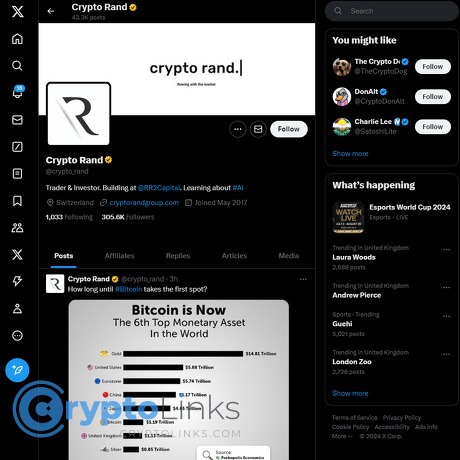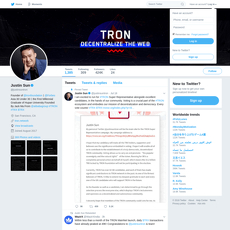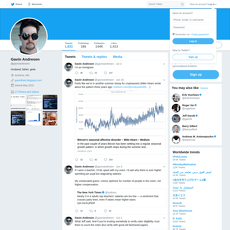Crypto Rand Review
Crypto Rand
x.com
Crypto Rand (X/Twitter) Review Guide: What to Expect, How to Use His Calls, and FAQs
Ever wonder if following a big crypto voice on X like @crypto_rand can actually help your trading — without wrecking your risk? Or if you’re just adding more noise to an already loud timeline?
I’ve spent years sorting signal from hype across crypto feeds. This guide is my practical playbook for using a popular account’s content the smart way — so you save time, stay in control, and avoid the traps that eat accounts.
The problems most people hit when following big crypto accounts
Let’s be honest: X is incredible for speed, but brutal for discipline. Here are the common failure points I see over and over — with real-world examples and a few data points to keep us grounded.
The signal-to-noise problem. You’ll see clean charts and strong opinions, but not always the context you need: timeframe, invalidation, position size. A tweet might show a breakout line on a 4H chart — great — but without risk parameters, that’s a teaser, not a trade plan.
Why this matters: attention-driven decisions push people to buy what’s “in front of them.” Classic research shows attention alone can drive buying behavior, even without conviction (Barber & Odean). And yes, social mood can move markets short-term (Bollen et al.), which is exactly why context is everything.
Copy-trading without a plan. You see a coin ripping, the account you follow likes the trend, and you jump in +18% late. No entry rules, no stop, no take-profit. A small pullback becomes a big hole.
Sample scenario: post says “looks strong into resistance.” You market buy. Price taps resistance, rejects 6%, you panic-sell the low. Two hours later the setup actually forms…and you’re out of ammo. This isn’t a TA problem — it’s a process problem.
Hype vs sponsored content. Not every bullish mention is an ad — but some are, and not all are clearly labeled. If you can’t tell whether a post is opinion, promotion, or both, your risk gets mispriced. Look for cues like #ad, “partner,” or “sponsored.” When in doubt, cross-check claims with actual data (volume, users, code commits, on-chain activity).
Imposter accounts and fake giveaways. Big accounts attract sophisticated fakes: swapped characters in the handle, reply-bots asking you to “DM for support,” and phishing “claim” links. Since 2021, people have reported over $1B lost to crypto scams, with nearly half starting on social media (FTC). Treat anything that asks for your seed phrase, wallet connect, or upfront “gas” as a guaranteed scam.
Paralysis from conflicting takes. Your feed says “breakout,” “distribution,” “range until CPI,” and “nuke soon” — all within 10 minutes. That clash breeds hesitation and FOMO-chasing. The fix isn’t to follow fewer accounts; it’s to build a simple process that filters them.
“A tweet can spark an idea. Your plan should decide the trade.”
One more thing: pump-and-dump patterns don’t just live on Telegram. Coordination and promotional surges happen across social platforms. Academic work has documented how quickly illiquid coins can be whipped around by attention bursts (Hamrick et al.). If you can’t exit without moving the price, you’re the exit liquidity.
The promise: a practical way to follow Crypto Rand (and stay in control)
Following a fast-moving account doesn’t have to be chaotic. Here’s what you can expect from this guide so you actually get value from Crypto Rand’s posts — without giving up risk control:
- Clear expectations on what his feed offers (and what it doesn’t).
- A 1–2 minute vetting checklist to spot real setups vs. timeline noise.
- Simple risk rules you can apply the same day — no fancy math.
- A clean X setup so ideas land in the right bucket, not your emotions.
- Fast answers to common questions people ask all the time: “Can I make $100/day?”, “What’s the 30‑day rule?”, “Why are my funds locked?”, “How much is $100 in BTC right now?”
Bottom line: treat posts as idea starters. Use your own plan to decide entries, invalidation, and size. This guide shows you how to bridge that gap in minutes, not hours.
Who this guide is for and what I reviewed
- Who it’s for: newer and intermediate traders who follow analysts on X, want structure, and prefer quick, repeatable checks over complex systems.
- What I looked at: post types (charts, narratives, reminders), tone, calls-to-action, engagement patterns during hot market moments (ETFs, halving, meme rotations), and the questions the community keeps asking.
- My stance: not here to stan or slam. Just a pragmatic review so you can make better decisions with less stress.
So, who exactly is Crypto Rand, and what can you expect from his X feed on a typical week — from chart snapshots to narrative takes? Let’s look at that next so you know what you’re actually getting before you act on a single post.
Who is Crypto Rand and what does he post on X?
@crypto_rand is a well-known trader and market commentator on X (formerly Twitter). His feed is what most people expect from “Crypto Twitter” at its best: quick reads, clean charts, and timely takes when momentum and narratives shift. If you like scanning your timeline on mobile, catching the gist in seconds, and then going to your chart to confirm, his style fits.
“Charts are opinions. Risk is fact.”
That’s the mindset I bring to his posts. They’re useful as fast context and idea fuel, especially in a market where attention and sentiment can move price. There’s solid evidence that social activity nudges crypto returns and volume—see how high-profile tweets affected markets in Ante (2021), and how investor attention ties into price in early Bitcoin research like Kristoufek (2013). In short: fast, visible updates can matter.
Quick snapshot
- Handle: x.com/crypto_rand
- Focus: market commentary, chart snapshots, trend talk, occasional education
- Audience: traders and investors who want quick momentum reads and narrative context
- Format: visual charts + short captions; sometimes threads when a theme heats up
Content pillars you’ll typically see
- Technical analysis charts
Expect clear levels, trendlines, and simple context like “reclaim,” “retest,” or “range.” It’s visual first—good for screeners who want a map, not a lecture.
Example-style note you might see: “BTC: weekly close above prior range high; watching for retest -> continuation. Invalidation: back inside range.” It’s a nudge to go validate on your own chart.
- Market sentiment and macro notes
Quick takeaways on Bitcoin dominance (BTC.D), ETH/BTC trends, liquidity pockets, or risk-on/off shifts. You’ll sometimes see mentions of DXY or rates when relevant—just enough to frame bias without turning into a macro thread.
- Project highlights during hot narratives
When themes catch fire (AI, RWA, L2s, new infrastructure, or the meme cycle), he’ll spotlight charts or short threads summarizing why traders care: catalysts, level to watch, and what would confirm continuation.
- Short educational reminders
Occasional posts about patience, invalidation, and risk basics. Think “wait for the retest,” “don’t FOMO mid-range,” or “respect your stop.” Simple, but the reminders help—especially in fast legs.
Posting pace and tone
- Timely and scan-friendly: the feed leans on high-level notes you can process in seconds.
- Visual first: charts drive the message. That’s smart on X—posts with images consistently get more engagement, which means more eyes on timely levels (Buffer’s analysis found image posts significantly boost interactions).
- Tone: pragmatic and momentum-aware. He’ll lean bullish or cautious with the trend, but you won’t get multi-page tutorials. It’s a heads-up, not a how-to.
Who benefits most (and who won’t)
- Great fit for:
- Traders who screenshot levels, set alerts, and translate charts into their own plan
- Swing and momentum followers who want fast narrative context without a deep research rabbit hole
- People who prefer clean visuals over long text
- Probably not for:
- Anyone expecting hand-held entries/exits, position sizing, or portfolio management
- Deep-value researchers who want fundamental reports and token-economics walkthroughs
If a crisp chart and a one-liner can spark a solid plan for you, you’ll get value here. But what’s the simplest way to turn those quick posts into trades you control—without chasing or second-guessing? Keep reading; I’ll show you the exact setup I use to go from “interesting idea” to a clear entry, invalidation, and alerts in under five minutes.
How to use Crypto Rand’s feed without getting wrecked
Ideas are everywhere. Risk isn’t. If you treat posts on X as green lights to buy or sell, you’re handing your account to the timeline. The smarter move: use Rand’s posts to spark research, then build your own plan around them.
“Amateurs want certainty. Pros want good odds.”
Set your X up right
Your feed should work like a watchlist, not a slot machine.
- Create a clean List: On X, make a List called “Market Analysts.” Add @crypto_rand and 3–5 other voices you actually use. Pin the List to your home tabs so you can switch to it in one tap.
- Turn on smart notifications: Hit the bell on key accounts and choose “Highlights” only. You’ll get the bigger posts without the noise.
- Filter for charts: When you’re on the List, tap the filter icon and select “Media” to scan chart posts at a glance.
- Mute distractions: In Settings → Privacy and Safety → Mute and block → Muted words, add:
- “giveaway”, “double your crypto”, “airdrop hunter”
- “signal/DM”, “join telegram”, “copy trade”
- “100x”, “guaranteed”, “risk-free”
- Use saved searches: Save queries like from:crypto_rand BTC or from:crypto_rand SOL to pull up asset-specific notes fast.
Separate ideas from trades
Before you click buy, make the idea earn its way into your portfolio. I keep a 5-line template in Notes and fill it in within two minutes.
- Thesis (1 paragraph): Why now? What would change your mind?
- Entry: Price or condition that must be true (e.g., “retest and hold above 200D MA”).
- Invalidation: The level that proves the idea wrong. No debate.
- Targets: A simple ladder (T1, T2, runner) with partial take-profits.
- Risk: Fixed dollar loss or % of equity.
Example: Rand shares a chart highlighting a possible SOL breakout above a key range.
- Thesis: “Range high reclaim on SOL with strong volume. If BTC stays stable and SOL holds above prior resistance, momentum likely continues.”
- Entry: 1-hour close above 195 with a successful retest.
- Invalidation: Clean 1-hour close back inside the range at 188.
- Targets: T1 205 (reduce 30%), T2 214 (reduce 30%), leave 40% runner with a trailing stop.
- Risk: 0.75% of account. If account is $10,000 and stop is $7 wide, position size ≈ ($10,000 × 0.0075) ÷ $7 ≈ $10.7 per $1 move ≈ 1.5 SOL per $10 move; round down to fit fees and slippage.
If you can’t write the thesis or define invalidation, skip it. No FOMO. There’s always another setup.
A 5-point vetting checklist for any post
Use this to turn a hot chart into a grown-up decision.
- Narrative: Is there a real catalyst or just vibes?
Check for upcoming events (mainnet, unlocks, ETF flows, major listings). A simple Google News search or a quick look at CoinDesk or The Block works. - Liquidity: Can you enter/exit without getting shredded?
Look at 24h volume and order book depth on your exchange. As a rule of thumb, your total position should be a small fraction of hourly volume; aim for slippage under 0.3–0.5%. - Levels: Are support/resistance clear and recent?
Open TradingView, mark the last swing high/low and the 200MA/EMA on your timeframe. If levels are messy or far away, reduce size or pass. - Asymmetry: What’s the downside if you’re wrong?
If your stop is 5% away and first target is only 3% up, the math is bad. I want at least 1.5:1 reward:risk; 2:1 is better. - Confirmation: Is something objective backing it up?
Look for volume expansion, open interest/spot volume alignment (e.g., Coinalyze), or basic on-chain activity trend for majors (Glassnode, Santiment).
Why this works: Research on investor behavior shows we’re wired to chase and hold losers. In equities, frequent traders underperformed by ~6.5% annually, largely due to overconfidence and poor timing (Barber & Odean, 2000). Crypto is faster and more volatile — discipline matters even more.
Simple risk rules that save accounts
- Risk a fixed fraction per trade: 0.5–1.0% covers most people. Formula:
Position size = (Account equity × Risk%) ÷ (Entry − Invalidation) - Only add to winners: If price moves 1R in your favor (distance from entry to stop), move stop to breakeven and consider adding with a tight, trailing stop. Do not average down blindly.
- Cap correlation: If you’re long three AI tokens, you don’t have three trades — you have one theme. Limit theme exposure to 2% risk total and 2–3 correlated positions max.
- Use a “tripwire” daily loss stop: If you hit −2% in a day, stop trading. Overtrading after losses compounds damage (again, Barber & Odean found the more investors traded, the worse they did).
- Pre-commit exits: Partial take-profits at 1R/2R reduce stress and let you trail the rest. It’s easier to be patient when you’ve already paid yourself.
Quick SOL example continued: If stop is $7 and price moves +$7 from entry, lock breakeven. At +$14, trail under the last swing low on the 1-hour or use a 2× ATR stop so you don’t get wicked out by noise.
Tools to cross-check quickly
- Charting:TradingView or your exchange charts.
60-second routine: mark S/R, check 20/50/200 MAs, add volume, draw the trendline. If the chart looks “in the middle,” patience usually pays. - News and flows: Use a fast feed like CoinDesk, DLNews, or a terminal-style feed. Check for macro landmines (FOMC, CPI) on an economic calendar.
- Liquidity and derivatives: Coinalyze or Laevitas for open interest, funding, and options skews. Spot up + OI up = healthy; spot down + OI up can flag crowded shorts.
- On-chain (for majors): Glassnode free dashboards or Santiment to see if active addresses and exchange flows support the move.
Remember: the post is the spark, not the trade. You bring the plan, the math, and the rules. That’s how timelines become tools.
One last thing: before you act on any post, how do you spot promos, conflicts, or low-quality signals in under two minutes? Keep reading — the next section breaks down what’s verifiable, what’s not, and the red flags that save you from costly mistakes.
What’s the track record? Transparency and red flags to watch
“Trust is earned in slices and lost in chunks.” In crypto, that line hits hard. One great thread can earn someone your confidence; one sloppy promo can erase it. So when you follow a big account like @crypto_rand, judge the process and the patterns you can actually see — not the PnL you can’t.
What I can reasonably verify
- Consistent, time-stamped market views. His feed is active with charts and levels you can cross-check against price action later. That matters more than victory laps.
- Alignment with major narratives. When market themes heat up (BTC dominance shifts, liquidity rotations, hot sectors), his takes usually sit inside those broader currents, which can help you orient fast.
- Engagement and feedback loops. Large reach means ideas get stress-tested in the replies. If a level or thesis is off, the crowd often flags it quickly — a useful social “audit” layer.
Tip: I keep a lightweight “shadow log” for any analyst I follow. Date, asset, thesis, key levels, what happened vs. BTC over 1–4 weeks. It keeps me honest about signal quality and stops me from remembering only the winners.
What I can’t verify (and you shouldn’t assume)
- Exact entries, exits, or fills. Screenshots are not trade confirmations. Without full, consistent evidence (order IDs, time-stamps, independent audit), assume examples are educational.
- Portfolio size or allocation. A 1% nudge for them might be a 50% swing for you. Never mirror sizing based on a tweet.
- Compensation or positions around mentions. Unless a post is clearly labeled, you don’t know if there’s sponsorship, advisory ties, or a bag behind the curtain.
Reality check: Peer-reviewed work in behavioral finance shows social media sentiment can move crypto in the short run, but the effect tends to fade quickly (often within 24–72 hours). That’s another reason to avoid assuming “he said it, so it’ll trend for weeks.”
How to spot promos and conflicts
- Labels and language: look for “ad,” “sponsored,” “partner,” “in collaboration with,” “ambassador,” “advisor,” “powered by.” If you see referral links (e.g., ?ref= or code: RAND), treat it as marketing, not neutral analysis.
- Claims vs. data: if a post says “massive growth” or “top-tier volume,” open a tab and check CoinGecko or CMC for market cap/FDV, volume quality, and recent unlocks. Numbers should match the story.
- Timing around catalysts: exchange listings, unlocks, or airdrop windows attract paid pushes. If you see a surge of identical talking points from multiple KOLs in hours, assume coordinated marketing.
- Vesting and insiders: check token unlock calendars and on-chain wallets (holders concentration). If insiders control the float, any “breakout” can rug on you fast.
Remember: Promos aren’t evil; hidden promos are. I’d rather see a clear #ad than soft-shoe shilling.
Common scam patterns around big accounts
- Reply-bot imposters: fake “support” or “DM me on WhatsApp/Telegram” accounts in the comments. Real analysts don’t cold-DM you for investments.
- Lookalike handles: swapped characters (l vs I, rn vs m) or slight misspellings with a paid checkmark. Always click through to the handle: x.com/crypto_rand.
- Giveaway traps: “Send 0.2 BTC, get 0.4 BTC back,” “airdrop claim” links, or fake winner lists. These are 100% scams — every time.
- Malicious “claim” sites: never connect your wallet from a reply link. If you did, go straight to a permissions manager (e.g., revoke.cash) and nuke approvals.
Emotional anchor: Scams spike when markets run hot because FOMO lowers our standards. When you feel “this is the one,” that’s exactly when to slow down.
2-minute sanity check before acting
- Verify the source: handle is @crypto_rand, not a lookalike. No sketchy links in the replies are steering you elsewhere.
- Check the timestamp and context: is this fresh? What’s BTC doing? If majors are puking, most alt theses are dead on arrival.
- Look for structure: chart with levels and invalidation, not just a slogan. If you can’t identify the “I’m wrong here” line, you don’t have a trade — you have a hope.
- Liquidity quick-scan: is there enough 24h volume and depth to get in/out without slippage? Sub-$10M daily volume = handle with care.
- Asymmetry test: rough 1:2 or 1:3 reward-to-risk? If risking 1% to make 2–3%, your break-even win rate is much kinder than chasing moonshots.
- Promo sniff test: any “partner,” “ref,” or “ambassador” tells? Cool — treat it as marketing and size down or pass.
One last nudge from experience: stories sell; numbers keep you solvent. If you want to pressure-test ideas fast without living on X all day, the right mix of analysts and data tools can do the heavy lifting for you. Curious which ones punch above their weight without overwhelming your screen time?
Smart complements to Crypto Rand’s feed
One strong voice can sharpen your edge — or tilt your bias. The trick is building an “info diet” that gives you timing, confirmation, and context without turning your tabs into chaos.
“Strong opinions, loosely held.”
Here’s how I round out a fast-moving X timeline with signal that keeps me honest and on plan.
Analyst styles to mix in
I think in “teams.” Each style covers a blind spot so I’m not over-relying on any single post.
Momentum/trend traders (for timing):
What I watch: higher-timeframe structure (H4/D1), prior day high/low, anchored VWAP, and simple continuation patterns.
Why: Crypto shows short-term momentum effects; when a narrative catches, clean breakouts often continue. I’ll only press when price reclaims a key level and volume confirms.
Example: If there’s a fresh SOL narrative and price reclaims prior day high + session VWAP with rising volume, I plan an entry on the retest and size small until it makes a higher high.
On-chain/data-heavy analysts (for confirmation):
What I watch: exchange netflows, active addresses trend, stablecoin liquidity, realized profit/loss spikes.
Why: Flows and activity can backstop a chart. Exchange outflows and rising stablecoin supply often align with risk-on stretches.
Example: If a new L2 is trending, I check TVL growth and gas usage. If TVL is flat and activity is falling, I don’t chase green candles.
Derivatives/flow watchers (for squeeze risk):
What I watch: open interest, funding, options skew/IV.
Why: Crowded positioning can precede violent moves. A jump in OI into resistance + negative funding = higher squeeze odds.
Example: BTC grinding up while funding stays negative and OI climbs — I keep a tight plan for a quick breakout continuation.
Macro voices (for risk regime):
What I watch: DXY, US 10Y, liquidity indicators, big macro prints (CPI, FOMC).
Why: Crypto’s beta shifts with dollar strength and rates. A roaring DXY often pressures alts; easing yields can re-open risk.
Example: If CPI surprises hot and DXY rips, I reduce alt exposure and favor defensive setups until volatility cools.
Fundamental/event trackers (for “landmines”):
What I watch: token unlocks, major listings, roadmap milestones, vesting cliffs.
Why: Supply shocks and catalyst timing matter. If a big unlock hits next week, I trim winners into strength.
Data and tooling that help
Tools are there to save attention. I use a few core dashboards and set alerts so I’m not glued to X.
Charting with built-in alerts:
TradingView or your preferred platform.
- Anchored VWAP from breakouts/major lows
- ATR-based stops for consistency
- Horizontal levels with “once per bar close” alerts
News aggregators with filters:
CryptoPanic style feeds help catch regulatory headlines, listings, and upgrades without scrolling endlessly.
Derivatives dashboards:
Coinglass or similar for OI, funding, liquidations. Watch for:
- OI rising faster than spot price (crowding)
- Persistent negative funding in uptrends (fuel for squeezes)
Options flow and volatility: Skew/IV boards (e.g., Laevitas-type tools) to sense fear/greed. Spiking downside skew can warn of hedging demand.
Liquidity/heatmaps: Order book heatmaps (e.g., TensorCharts-style) to see stacked bids/offers near your levels. Helps avoid entering into a wall.
Token unlock calendars: TokenUnlocks-style trackers to spot supply events. I set reminders 7 and 1 day before large unlocks.
Three-alert template I use:
- Breakout/Breakdown: prior day high/low on your key pairs
- Invalidation: stop level alert to avoid “hope holding”
- Sentiment: funding extreme (e.g., +0.1%/8h or −0.1%/8h) on majors
Quick Sunday ritual (10 minutes): refresh levels, update alerts, skim derivatives dashboards, and note two narratives you’ll allow yourself to trade this week. Everything else gets muted.
Education hubs worth your time
Calls can spark ideas, but skills keep you in the game. I carve out a little study time each week and focus on what compounds.
Risk management primers: Fixed fractional sizing (0.5–1% risk per trade) beats “feels-based” sizing. Classic research on overtrading shows returns suffer when activity spikes without edge — fewer, higher-quality bets tend to win out.
Pattern playbooks you can backtest: Range breakouts, retests, and trend pullbacks. Use bar replay and a simple rule set: 1R risk, 2R target, no averaging down. Track 50 trades; your stats will tell you what to keep.
Exchange how-tos: OCO orders, reduce-only, and conditional stops. Knowing these prevents most “I blinked and it ran away” moments.
Options basics for spot traders: You don’t need to trade options to learn from skew and IV — they’re useful sentiment gauges during event weeks.
Psychology habits: A written pre-trade checklist, a “two loss max per day” rule, and a 24-hour cool-off after a tilt. Boring wins.
Try this micro-backtest: 20/50 EMA cross on the 4H, only take longs when price is above the daily anchored VWAP, 1 ATR stop, 2R target. Log 30 trades. If win rate and R multiple don’t beat “buy and hold” for that period after fees, it’s not your setup.
Save them into folders: Analysts, Data, Risk, and Playbooks. When a hot take hits your feed, you’ll have two clicks to validate narrative, liquidity, and risk instead of guessing.
One more thing — you don’t need more noise; you need better filters. Want straight answers to the questions I get every week (like “Can I really make $100 a day?” or “Why is my crypto locked?”)? You’ll like what’s next.
FAQ: straight answers to common questions
Can you make $100 a day with crypto?
Yes, sometimes. Consistently? That is where most people struggle. The bigger your account and the tighter your process, the more realistic it gets.
- What the math looks like: If you risk 1% per trade and your average expectancy is +0.25R (example: 50% win rate with +1.5R wins and -1R losses), that is +0.25% of your account per trade.
Example: $5,000 account x 0.25% ≈ $12.50 per trade. You would need ~8 solid trades to hit $100. On a $20,000 account, that is ~$50 per trade; two good trades can hit the target.
- The catch: daily PnL is lumpy. Even skilled traders see red days. Forcing a daily dollar target usually leads to revenge trades.
- Evidence check: Multiple studies on day trading show a small minority achieve persistent profits (e.g., Barber et al., 2014; the Brazilian CVM study). The lesson: skill and discipline matter more than hype.
How I frame it:
- Focus on weekly/monthly targets, not daily.
- Use fixed fractional risk (0.5–1% per trade) and track your win rate, average R, and trades per week.
- Mix in steadier inflows: staking major assets, conservative yield on stablecoins with reputable venues, or simply holding cash when setups are not there.
How much is $100 worth in crypto?
It changes minute to minute. Always use a live converter or your exchange’s quote.
- Quick formula: Amount of coin = $100 / live price. If BTC is $70,000, then ~0.001428 BTC. This is an example only — check live rates.
- Fees and spread: Expect 0.1–1% total cost on major exchanges. Network fees apply when withdrawing (ETH can be higher; cheaper networks like Tron or Arbitrum may help).
- Pro tip: If you are buying spot, a limit order at a sensible level often reduces slippage. Double-check the network when moving stablecoins (USDT ERC20 vs TRC20 vs Arbitrum) to avoid surprise fees.
What is the 30-day rule in crypto?
In the U.S. right now: the classic stock “wash sale” rule does not generally apply to crypto at the federal level. That could change, and some proposals have floated around. Many traders still wait 30 days after selling at a loss before rebuying the same coin to keep records clean.
Outside the U.S.:
- UK: HMRC’s 30-day “share matching” rules do apply to crypto assets.
- Canada: The “superficial loss” rule (30 days) can apply to crypto.
- Australia: The ATO has anti-avoidance rules around wash sales even without a fixed 30-day timer.
What I do:
- Keep detailed lot-level records (date, amount, cost basis, fees).
- Use specific ID when supported; know your FIFO/HIFO setting.
- Run your account through a tax tool and confirm with a local professional. Rules change, and fines are not fun.
Why is my crypto locked?
There are a handful of common reasons — and quick fixes.
- Open orders: Funds are reserved for limit orders on spot or futures. Fix: cancel or modify open orders.
- Collateral: Margin/derivatives positions tie up assets. Fix: reduce position size or change collateral settings.
- Staking/earn products: Some products have lock-ups or unbonding windows (e.g., Cosmos ~21 days; Polkadot ~28 days; ETH withdrawals can queue). Fix: check the product’s terms and initiate unstake/withdraw.
- Pending deposits/withdrawals: Bank ACH or card buys often have hold periods (3–7 days is common). Fix: wait for settlement or use instant methods with known limits/fees.
- KYC/AML checks: Compliance flags can freeze transfers. Fix: complete verification and respond to support requests.
- Maintenance/network issues: Exchanges may pause transfers during upgrades; blockchains can congest. Fix: check exchange status and blockchain explorers.
Where to look first: your Open Orders, Earn/Staking, and Withdrawal History tabs usually call out the exact reason and next step.
Is following Crypto Rand enough to trade successfully?
No single account is enough — his posts are great for ideas, not for handing you entries, exits, and position sizes. The edge comes from your process: a clear thesis, defined invalidation, realistic targets, and risk that fits your account. Use his charts as a nudge to do your own work, not as a green button.
Want the simple, repeatable way I turn any tweet into a trade plan in under 90 seconds — with alerts so I am not glued to the feed? That is exactly what is coming next.
Action plan: get value from Crypto Rand without losing the plot
Here’s the playbook I actually use. It keeps the good stuff (context, fast charts, fresh ideas) and filters out the chaos. You’ll know exactly what to do when a post hits your feed — and how much to risk.
Organize
- Create a “Market Analysts” List and add @crypto_rand plus 5–10 voices you trust. Pin the List and use it as your morning/evening scan.
- Turn on notifications for just 2–3 accounts that consistently post levels you trade. Anything more becomes noise.
- Mute distraction keywords: giveaway, airdrop, double your crypto, signal group. You’re protecting attention, not being a snob.
Plan
- Treat every post as an idea, not a signal. Convert it into one clear plan before clicking buy or sell.
- Use a lightweight template so your brain can’t skip critical steps.
Trade Idea Template (60 seconds)
- Asset & setup: ____ (trend, breakout, mean-reversion, narrative)
- Entry: ____ (exact level or condition, e.g., “reclaim + retest” case)
- Invalidation: ____ (price that proves me wrong)
- Targets: ____ / ____ (ladder exits, partials okay)
- Size: risk $____ (0.5–1% of equity) ÷ stop width = position
- Timeframe: ____ (intraday, swing, position)
- Notes: catalyst/confirmation (volume, news, on-chain)
Protect
- Cap risk per trade at 0.5–1% of your account. This keeps you in the game when volatility spikes. The “fractional Kelly” idea is popular for a reason — smaller than full Kelly helps reduce drawdowns and tilt (see Ed Thorp’s work on the Kelly Criterion: SSRN).
- Limit theme exposure. If you take two AI tokens plus an AI infrastructure coin, that’s one big bet wearing three tickers. Keep narrative heat under 30–40% of your book.
- Only add to winners with a trailing stop. Never average down because a thread sounds confident.
- Track results weekly. If an idea type bleeds, pause it. Overtrading destroys edge (see Barber & Odean’s “Trading Is Hazardous to Your Wealth,” showing active individual traders underperform due to overtrading: PDF).
A quick real-world example
Say a post highlights “SOL reclaiming a key level; watching strength on retest.” Here’s how I’d turn that into a plan:
- Setup: Trend continuation on reclaim.
- Entry: 156.5 after a clean retest (close back above + bullish 15–60m structure).
- Invalidation: 151.8 (below reclaimed level and last swing low).
- Targets: 171 (prior supply), 186 (measured move).
- Risk: $10,000 account, 1% risk = $100. Stop width ≈ $156.5 − $151.8 = $4.7. Position ≈ $100 ÷ $4.7 ≈ 21 SOL. Round down for fees/slippage to 20.5 SOL.
- Confirm: 24h volume healthy and order book not thin. Thin books can gap through stops; Kaiko’s market-depth data often shows how quickly alt liquidity dries up on moves (Kaiko Research).
If it never retests with confirmation, I don’t chase. Alerts do the watching; I do the executing.
Quick setup checklist
- Lists: Make three — Analysts, News, Data. Pin them. Scan Analysts for ideas, News for catalysts, Data for confirmation.
- Template: Save the trade template above in your notes or journal app. No template, no trade.
- Alerts: Set price alerts at key levels so you act on your plan, not your feed. I’ll place alerts for the reclaim level, invalidation, and first target.
- Heat guardrails: Max 3 correlated positions at once. If BTC dominance is ripping, trim alt exposure accordingly.
- Daily stop: Hit −2R or −3R for the day? Close the platform. Protecting mental capital is edge.
- Journal: Log entry reason, risk, outcome in R. Expectancy = (win% × avg win R) − (loss% × avg loss R). Your numbers > any influencer take.
One more tip: audit your feed monthly
- Keep what pays: Look back 30 days. Which voices led to profitable, low-stress trades? Keep them. Mute or remove the rest.
- Trim noise: If an account pushes you to chase or overtrade, it’s a cost center. Barber & Odean’s findings are a good reminder: activity for activity’s sake hurts returns.
- Refresh narratives: Update your watchlist to match what’s moving now (L2s, RWA, AI, perp dexes). Correlations shift; don’t keep last quarter’s playbook. Binance/Kaiko correlation dashboards can help you spot clustering and avoid doubling up on the same beta.
- Recalibrate risk: Vol up? Drop to 0.5% risk. Vol down? You can consider 0.75–1% with clear invalidations.
Conclusion: my take
Use fast posts for context and idea generation, then slow things down with your plan, your risk, and your tools. When you organize your feed, predefine entries and invalidations, and cap position heat, you get the upside of following big accounts without handing them your PnL.
Save this guide, share it with a friend who “almost bought the top,” and trade your plan — not your timeline.
CryptoLinks.com does not endorse, promote, or associate with Twitter accounts that offer or imply unrealistic returns through potentially unethical practices. Our mission remains to guide the community toward safe, informed, and ethical participation in the cryptocurrency space. We urge our readers and the wider crypto community to remain vigilant, to conduct thorough research, and to always consider the broader implications of their investment choices.













